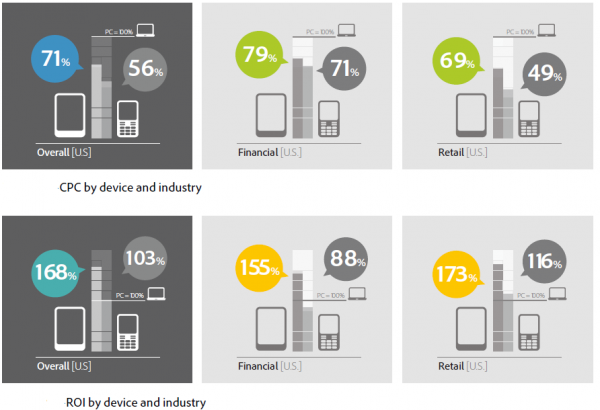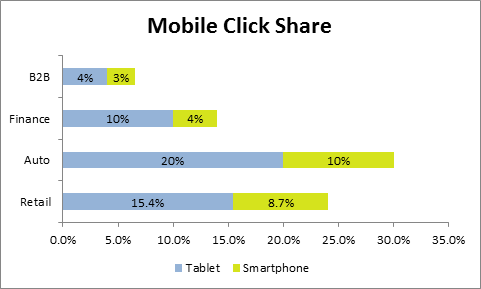3 Mobile Trends Every Search Marketer Must Know
When I last blogged about mobile trends in 2011, I had predicted that mobile, i.e., smartphone + tablet traffic would be 10% of all paid search traffic by the end of 2011. I had also predicted that mobile traffic would be between 16-22% of all traffic. It turns out, at least for a few categories, […]
When I last blogged about mobile trends in 2011, I had predicted that mobile, i.e., smartphone + tablet traffic would be 10% of all paid search traffic by the end of 2011. I had also predicted that mobile traffic would be between 16-22% of all traffic. It turns out, at least for a few categories, that I had under-predicted the rise of mobile.
An analysis of mobile traffic of a cross section of advertisers reveals up to 25-30% of all paid search traffic is now mobile. It is now more important than ever before to pay attention to your mobile targeted search campaigns. In this post, I shall talk about three key trends that every search marketer would do well to know.
Trend #1: Mobile Traffic Is Rising Fast… Faster Than You Think
The chart below shows the breakout of mobile clicks on Google between smartphone and tablet as a fraction of total traffic for a sample of our customers. While mobile has a small share of paid clicks in B2B, it comprises between 25-30% of clicks in the automotive and retail sectors.
That’s over one in four paid clicks! It is also interesting to note that while the bulk of the increase in mobile traffic is coming from tablets, a significant portion is also coming from smartphones.
Trend #2: Tablets Currently Have A Much Higher ROI Than Desktops
In a rational marketplace, the CPC of an ad is proportional to the ROI on the ad. In other words, if an ad unit has a good ROI, marketers are willing to pay more for the ad, and hence, its CPC increases. However, our research also shows that when it comes to tablet traffic, the market is not rational.
As smartphones don’t convert as well as desktops, advertisers are unwilling to pay a higher CPC on them. As a result, smartphone CPCs are about half of desktops. This CPC normalization means that ROIs on smartphones and desktops are almost identical.
However, in the case of tablets, CPCs are 30% lower even though they convert 20% better than desktops. Thus, ROI on tablets is 70% better than desktops. This represents a significant opportunity for the savvy marketer.

Trend 2: ROI on tablet devices is much higher than desktops while the CPCs are disproportionately lower.
Trend #3: ROIs Can Vary Significantly By Mobile Device
Earlier this year, Mark Ballard from RKG showed that ROI varied significantly by mobile device, i.e., the ROI on iPad, Kindle , Android tablet, etc. varied significantly. Our research shows a similar trend as we found that the ROI from iOS users is about double that of Android users.
The reason why the ROI differs so much is because of demographics, user experience, form factor and the context in which these devices are used.

ROI on ioS devices is 2x better than Android. A big part of the improved ROI can be explained by the higher conversion rates.
Tips to make your mobile search marketing program effective:
- Analyze mobile traffic trends for your own campaigns. As the first chart shows, mobile traffic can vary significantly by the type of business one is in. In general, retail B2C has the highest proportion of mobile traffic, while B2B and Financial advertisers see the least amount of smartphone and tablet traffic. If you find a significant proportion of traffic coming from mobile devices, you need a mobile-centric paid search strategy.
- Build tablet and smartphone specific campaigns. While it is tempting to take an existing campaign and target all devices, it is best to build tablet- and smartphone-specific campaigns despite the extra work. Since the CPCs and conversion rates are different, ads of the same keyword must be bid differently by device.
- Go beyond the brand keywords. Many marketers think that the ROI on mobile devices is poor and only build brand keyword campaigns to maintain some presence on mobile devices. However, I have seen several instances of ROI-positive campaigns on smartphones driven by non-branded, mobile-targeted campaigns. This is something every marketer with substantial mobile traffic should try.
- Try OS and device specific targeting. As the ROI on different mobile devices varies, it is worth trying OS and device specific targeting. Of course, this only makes sense when there is a substantial amount of mobile traffic, or else one ends up splitting a small fraction of mobile traffic with little to no incremental gain.
- Build mobile friendly sites. Sounds obvious, but it’s remarkable how many marketers have not built mobile friendly sites. Quite understandably, among the many priorities marketers had, mobile-friendly sites were low on the list, given the small percentage of mobile traffic they saw in the past. But, with the rapid change in traffic patterns developing, these sites have become imperative.
I hope these tips help you build a successful mobile paid-search strategy and help you reach, engage and convert consumers in the new multi-screen, multi-device world.
Contributing authors are invited to create content for Search Engine Land and are chosen for their expertise and contribution to the search community. Our contributors work under the oversight of the editorial staff and contributions are checked for quality and relevance to our readers. The opinions they express are their own.
Related stories
